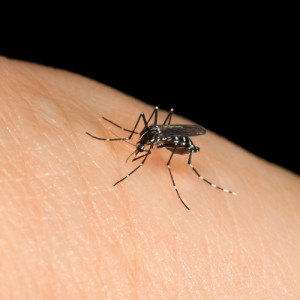We have more than a few species of disease-carrying mosquitoes in the US. Are we likely to add more?
The newest foreign mosquito invasion occurred a year ago in Cuba. Will it come to the United States?

The Asian Tiger mosquito has distinctive black and white striped legs.
A mosquito trap is set at Guantanamo Bay detention camp every week. Typically close to human sleeping quarters, the trap can catch up to 3,000 mosquitoes in only one week. Captured mosquitoes are sorted and sent to Maryland for identification. Researchers at Fort Meade are so versed in mosquito species identification, they can identify them by sight. When an unidentifiable mosquito is found, it is sent for DNA testing. This happened in January 2019, when a strange-looking female mosquito was found. Like the Asian Tiger mosquito, she was very distinct in appearance. She had marked white spots on her abdomen.
Who, or what is this new mosquito threat?
After this new mosquito’s DNA was tested, it was found to likely hail from India. The species, Aedes vittatus, is new to the western hemisphere, but it is not a new species. Originally identified in 1861, this new invader could become the latest mosquito threat for the United States. The Aedes vittatus is a known carrier of many dangerous mosquito-borne illnesses. Namely, she is a confirmed carrier of Zika, chikungunya, dengue, and yellow fever. We will likely begin to see natural spreading of this mosquito species in the southern U.S. in due time.
How did this new mosquito threat make it to North America?
“I just flew in, and boy, are my arms tired!” If you are thinking that mosquitoes fly across continents or oceans to arrive at their new foreign destinations, think again. Most mosquito species only fly within the distance of a city block or two. Additionally, they do not live long enough to make a long journey unassisted. So, how do they travel long distances? Perhaps in a way you never considered! Mosquitoes lay their eggs in water, and it only takes a small amount – about the size of a bottle cap is all that is required. When a female mosquito lays her eggs around shipping ports, those eggs can end up on or inside a shipping container. When the container arrives at its destination, so too, do those eggs. Once hatched, the mosquitoes are now in another region or country. The effects of climate change and shorter winters will allow all mosquitoes to live longer and mate more. The result is two-fold. We have more domestic mosquitoes and we can acquire foreign mosquitoes. They continue to proliferate naturally. Even though this new mosquito threat does not bring with it new diseases, it does reinforce the urgency to control mosquito populations.

Mosquito eggs travel by shipping container.
Mosquito removal is the best way to fight growing mosquito populations.

Mosquito control should be applied about every two weeks.
Effective mosquito control is our best bet in lessening the threat of mosquito-borne illnesses. Reputable mosquito control companies in Massachusetts offer this effective control with barrier mosquito sprays. Available in both all-natural and EPA-registered formulas, professional mosquito control will protect your home and family for a couple of weeks between sprays. It is also important to remember to use personal protection when you go outdoors away from your home. There are also all-natural and chemical repellents to keep you safe while hiking, attending outdoor parties, or going to the beach.
